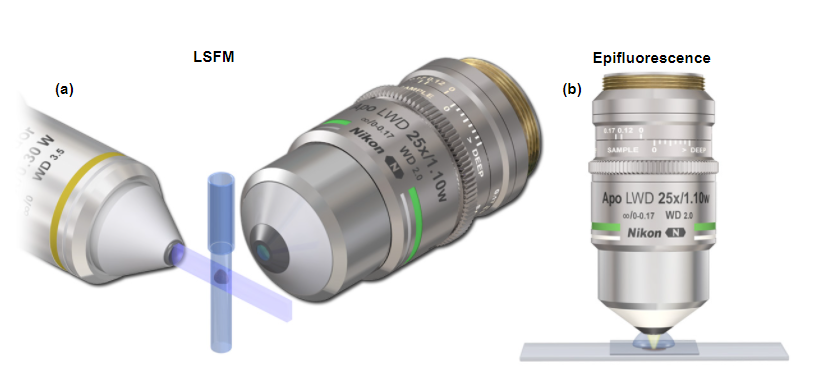Lightsheet and Specialty Microscopes
Light-sheet microscopy is a growing area in the field with many different variations being developed and published, due to the enhanced benefits on speed, signal to noise and resolution this modality has over traditional imaging techniques. Put simply, the main difference between traditional imaging modalities and light-sheet microscopy is the decoupling of the excitation light-path from the detection light-path. In traditional imaging modalities (widefield and confocal), excitation light illuminates the sample through the Z-axis and emission light is collected with that same objective, this results in the entire Z-axis being illuminated for each plane of the acquisition. By comparison, light-sheet microscopy works by illuminating a single plan of the sample with a sheet of light, minimizing out of focus light while greatly increasing signal to noise.
Most light-sheet microscopes have at least two objectives, one for excitation and one to capture emission light, as per the diagram below. Acquisition speed can be sped up by moving the illumination sheet, rather than the sample while spatial resolution can be increased by using thinner illumination light-sheets and/or high-NA collection objectives. There are many different variations on Light-sheet microscope designs to cater for very small samples (e.g. cells) through to larger whole organisms (e.g. Zebrafish), or for very high-speed acquisitions, or very high-resolution systems, but as with most imaging modalities, there is no single system that can achieve everything.

Source: MicroscopyU
Contacts
Dr James Springfield
Microscopy Facility Manager
+61 7 334 62390
j.springfield@imb.uq.edu.au
Dr Nicholas Condon
CZI Imaging Scientist
+61 7 334 62042
n.condon@imb.uq.edu.au
Dr Mahdie Mollazade
Microscopy Officer
+61 7 334 62042
m.mollazade@uq.edu.au
Mailing address
Advanced Microscopy Facility
Institute for Molecular Bioscience
Level 6N, 306 Carmody Road,
Building 80
University of Queensland
4072, St Lucia,
Queensland, Australia
